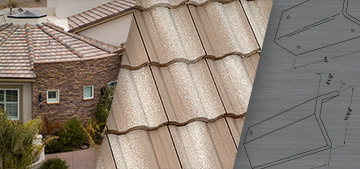While concrete roof tiles are among the most durable of roofing materials, breakage may occur during the shipping, delivery or installation processes. To ensure the tile roof system is not compromised, roofing professionals often want to know what constitutes as a “broken” tile and when should it be replaced versus being repaired. Here are some key guidelines that should be considered when evaluating the proper course of action:
- If the tile is cracked or broken across the face of the tile in either direction, it should be replaced.
- If the damage is slight – either with chipped or broken edges – the tile can be still be used in areas such as the hips, valleys, rakes or other places requiring cut tiles. These tiles should be identified and sorted during the loading process.
- The under lock portion of the tile will carry water even if the cover lock corner is chipped or broken. Since the
 required overlap of the installed tile is usually 3 inches, it logically follows that any broken corner exceeding 3 inches in length should qualify that tile for replacement, whether it is the under or cover lock portion of the tile. It is generally advisable to replace tiles which have broken under locks.
required overlap of the installed tile is usually 3 inches, it logically follows that any broken corner exceeding 3 inches in length should qualify that tile for replacement, whether it is the under or cover lock portion of the tile. It is generally advisable to replace tiles which have broken under locks. - If the cover lock corner is broken less than 3 inches, and the broken piece is available, it may be possible to repair the corner by proper adhesive application. Using an adhesive specifically formulated for concrete or clay roof tile, follow the manufacturers’ instructions to form a complete bond along the fracture. Take precautions not to allow excess adhesive to bond to the adjacent tile or create water blockage in the under lock.
- If the corner piece is not available, aesthetics become a factor that must be considered. A small chip may not be noticeable to the homeowner on a shallow sloped roof, but may be at a steeper slope. In any case, good judgment should dictate whether the missing corner affects the integrity of the water shedding capability of the tile.
- On some tile designs, such as shake profiles, the bottom edge of the tile may be distressed to create a more jagged or random appearance. This process will sometimes create small chips that should not affect the integrity of the installation, provided they meet the criteria mentioned above.
When handling the tile, it is important to handle each piece with care and refer to the TRI Installation Guide for proper installation methods in your region.
For additional information regarding the installation of concrete roof tile, visit the Tile Roofing Institute’s website, or contact your local Eagle Account Representative.



